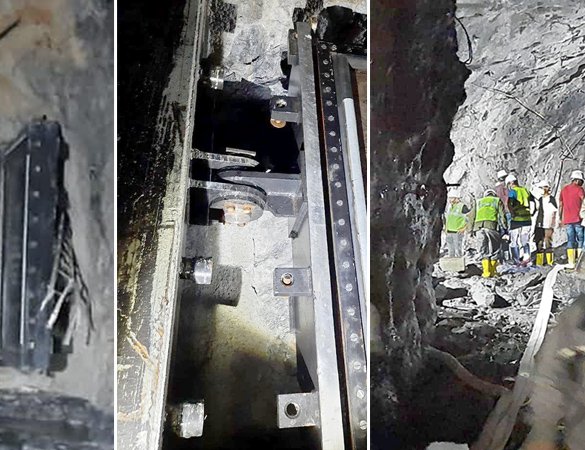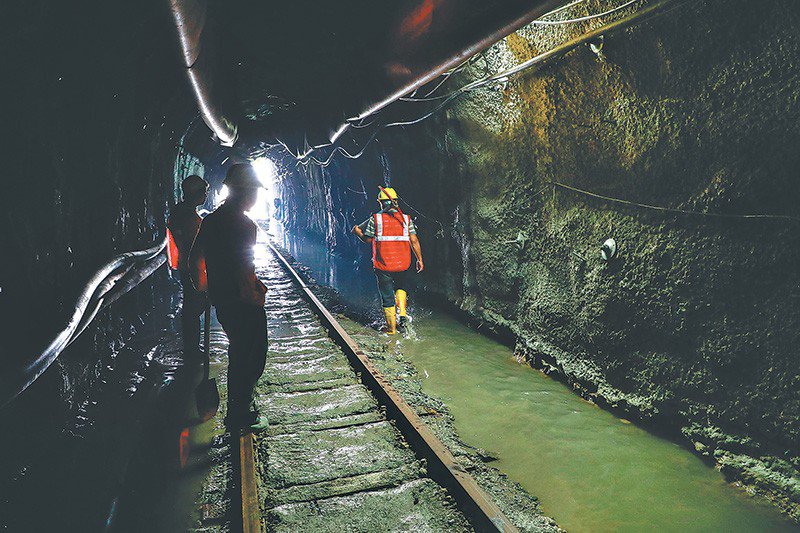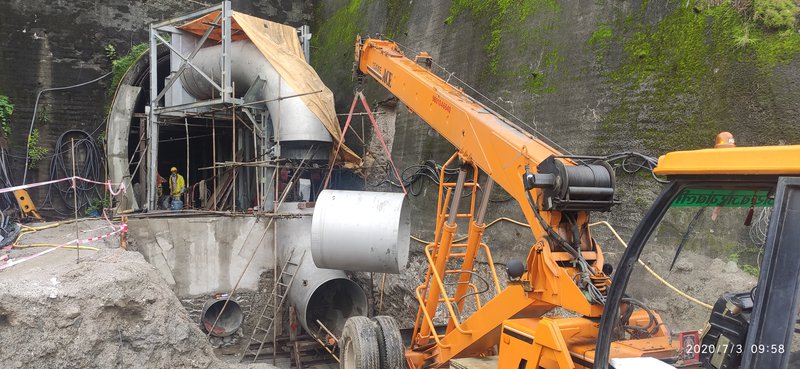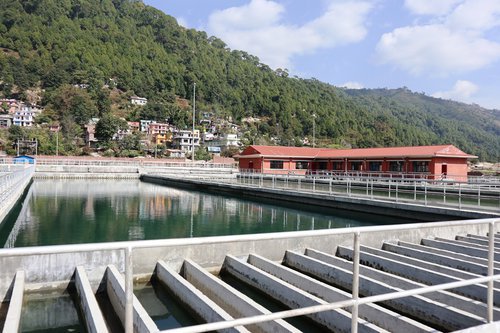
With the successful diversion of water from Melamchi River to the tunnel as planned, there were huge euphoria and jubilation among all the people involved in the construction of the largest tunnel of Nepal. However, the news of the bust of the bulkhead gate, a critical part of the tunnel, at around 12 noon on July 14 and two deaths have turned the situation into a grim mode.
The upbeat mood of Minister for Water Supply and Sanitation Bina Magar, secretary Madhav Belbase, Executive Director of Melamchi Water Supply Development Board Tiresh Prasad Khatri, project staff and everyone working to bring the water in Kathmandu by end of September was completely shattered.
Although the testing and commissioning process of the tunnel does not always pass smoothly and sometimes a technical error may prove fatal, this situation occurred with Melamchi Tunnel.

Minister Magar
A technical mistake related to the position of gate and nut and bolt has sent the entire project panicking for a few days. Position of Gate and nut and bold is a critical part of any tunnel. Experts argue that it was overlooked in the testing and commissioning period.
With the information coming to the Ministry, everyone looked nervous and helpless. There was completely lull and sadness. Having technical knowledge about the tunnel testing and commissioning and designing, secretary Madhav Belbase, who was closely associated with designing of country’s major irrigation projects and very diversion, quietly started to think about the next steps to take.
Given such a situation, there was no option before him other than to suggest a future course. After intensive meetings with the staff of the Ministry and Melamchi Water Development Board and consultations with tunnel experts, secretary Belbase immediately moved a proposal to constitute a technical committee to investigate the cause behind the incident.
With the approval of Minister Magar, an investigation committee has been formed under the leadership of Joint Secretary Ramakant Dawadi to investigate technical, mechanical and other technical errors behind the incident.
“The incident was unfortunate because of the death of two of our young technical staff and injury of the other two. Had we avoided human casualty, it would have done a great miracle,” said secretary Belbase. “However, we have learned a great lesson from this incident and the lesson can be used to avert such incidents in future and other projects.” It is a critical part of the tunnel which has to withstand 40 meters of water pressure. “

Secretary Belbase
Some experts blame for the installation of the gate. “Had the gate fit from inside the tunnel as per the tunnel’s specification and design, the incident would have been averted. However, the tunnel gates fitted from outside by changing the specification reportedly caused the damage,” said an expert.
An expert working in the project said that they do not have adequate communication with the manufacturer and the whole team on the gate and its issue. He acknowledges the fact that there is a lapse of communication.
“There must be a misunderstanding between the contractor and consultant. The drawings were approached from inside and later on the consultant communicate to install from outside,” said an expert. As the spread of COVID-19 and lockdown has badly affected the communications among different parties involved in the production of gates and technicians involved in the fitting. Almost all discussions heled through online regarding the technicalities and critical issues."
It is reported that the main reason for the failure of the gate is that the door opened into the adit, rather than into the main waterway. Had it been installed to open into the waterway, it would have been self-locked by the water pressure. As the gate fitted in adit, the water pressure instead pushed the adit door open and unimaginable incident occurred.
According to a report presented by the inquiry committee, there is no structural damage to the tunnel and its rock support in filling and the rapid emptying of the tunnel. Similarly, the rock of audit and other infrastructures remains intact.
The tunnel is designed as a lined tunnel with rock bolts and shotcrete for immediate support and with 35cm of shotcrete final lining were specified by the design. It reaches in good quality rock classification, 1, 2, and 3 remaining unlined.
With the incident, the Ministry has already directed the project to install the gate into the waterway as proposed in the design. According to project officials, this will take another two to three weeks.
What happened?
On July 14 around 12 noon, an Adit bulkhead gate in Aambathan suddenly burst, sweeping away two, an engineer and driver of the project, with the vehicle. They died. Two others were left injured.
Engineer Satish Goit of Dhanusha district representing the contracting company Sinohydro and driver Radha Krishna Thapa of Godavari in Lalitpur employed by MDWP died. Two others — Engineer Shekhar Khanal of the project and consultant Pemba Lama, a resident of Melamchi — were also in the vehicle when water gushed out of the tunnel.
“This is caused by technical error in the critical parts of the tunnel. What damage it has done is that it pushed the testing and commissioning process a bit later. I am sad that we have lost two valuable human lives. After correcting the mistakes, we will start testing and commissioning in a more safer and secure manner,” said secretary Belbase. “We have learned a big lesson by paying a high price.”

Rajendra Prasad Pant, information officer of the project, said staffers had gone inside the tunnel to repair the flossing gate. An investigation into the cause of the accident has completed and already submitted the report with recommendations to avoid failure in such critical areas.
The 27.5km long Melamchi raw water supply tunnel to bring fresh water to Kathmandu city in Nepal is close to being finished and inaugurated. Excavation is complete, the upstream run-of-the-river diversion weir and intake structure is about 80 percent complete and work is progressing at the downstream infrastructure on a sedimentation facility before directing raw water into a new treatment plant.

The project aims to supply 170 million liters of freshwater/day to the capital city. Drill blast excavation of the 27.5 km long tunnel progressed, in addition to works at the portals, from 18.4 m 2 intermediate adits, the main ones at Ambathan, Gyalthum and Sindhu.
The project has decided to water-up a tunnel from the Melamchi River test its hydraulics and operating mechanical equipment. The aim was to complete the long-awaited and urgently needed project by the end of the year.
There are a total of 29 control gates for the operation of the water supply tunnel including five 12.5m 2 adit bulkhead gates with a radial gate at the intake and a control gate at the downstream end.
The gates for the project are designed, supplied and imported to Nepal and installed by a company from India. The project contractor, Sinohydro of China, completed the civil works associated with the installation of the gates including the rock support around the doors and the shotcrete support of the adit junction with the main tunnel. All the adit gates were closed ahead of the watering-up test.
On 5 July, Sinohydro released water into the tunnel via a temporary pipeline and the temporary dam erected on the Melamchi River to begin its filling. However, on 14 July, Gate 17 at the end of the Ambathan adit failed, bursting open and allowing water in the tunnel to flood out in a torrent.

Gate 17 is at the end of the first adit from the upstream end of the waterway. The adit is about 800m from the intake portal of about 300m long. The waterway tunnel has a gentle gradient with a head of about 13m over the 27.5km of the tunnel. The tunnel is designed to run full and under pressure to operate the outlet pipe in the tunnel crown at the downstream end.
For the test, the tunnel was being filled at a rate of about 0.26 liters/sec, or about 20% of the designed inflow at the intake during inaugurated operation. At this rate, it would have taken an expected 15 to 20 days to fill.
Experts said that the accident was caused due to error in the knot bolts used to lock the adit bulkhead door. The door had been tightened with 30-knot bolts. The knot bolts slipped due to the water pressure, which unbolted the door.
At the time of the accident, the Ambathan gate had about 2m of static water head and about 1.6 bar or about 16m of pressure measured as acting on the door. The gate is designed for 50m of water pressure.
A senior project official said it would take around three weeks to repair the damaged tunnel gate. With four major gates along the tunnel—one each in Ambathan, Gyalthum, Sundarijal and Sindhu, the gate 17 in Ambathan was breached due to high water pressure.

Project Chief Khatri
With secretary Belbase who has been quietly working with his colleagues to repair the damage following all the checklist and safety protocols, one can expect that the process of diverting the water to tunnel and testing and commissioning will start within three to four weeks. This time they will follow all protocols and steps with a great tragic lesson they have behind them. For the young minister Magar, the completion of the project is a great pride and for secretary Belbse, who will retire within a year, is a major prize in his carrier. For project Khatri, it will be a great relief and pride as well.

Keshab Poudel
Poudel is the editor of New Spotlight Magazine.
- IWMI: SoLAR Global Science-Policy Forum Conference
- Apr 25, 2024
- CLA: Samriddhi For Skill Development
- Apr 23, 2024
- ECONOMY: Growth At 3.3
- Apr 16, 2024
- DPM’s SHRESTHA’S CHINA VISIT High Profile, Low Key
- Apr 14, 2024
- Maha Kumbha In Barahkshetra: A Sacred Festival In Sacred Koshi (Kaushiki) River
- Apr 09, 2024
















